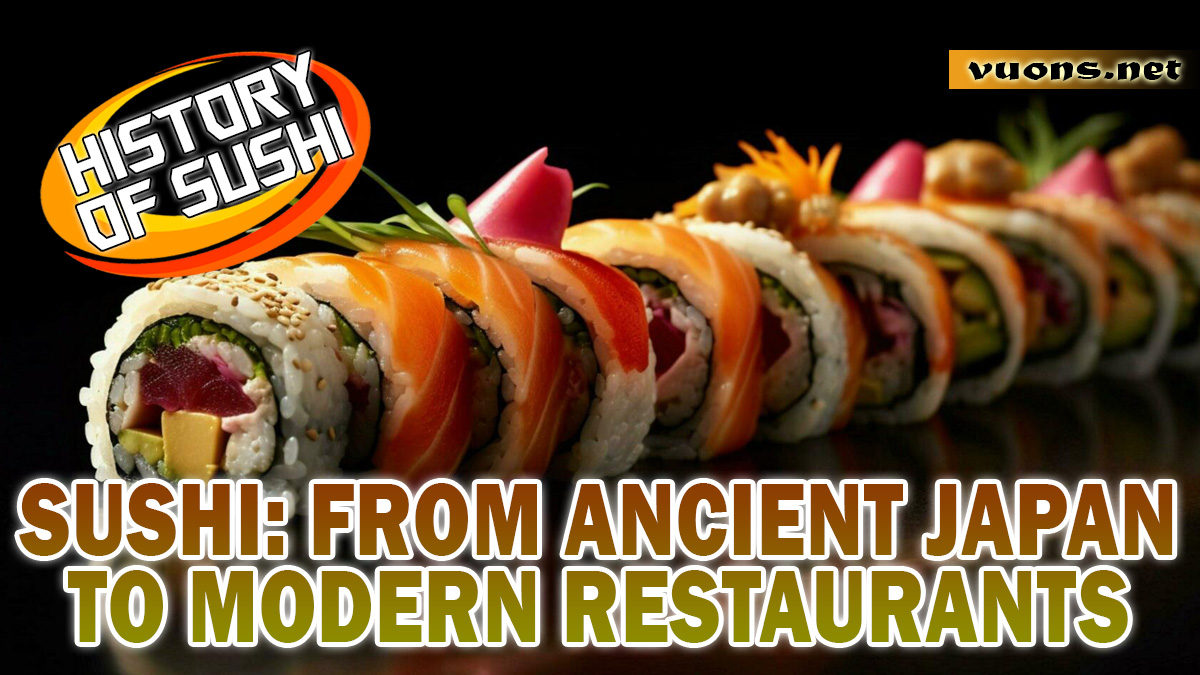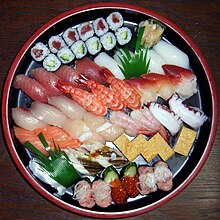Sushi: From Ancient Japan to the Modern Restaurant
The Origin and Development of Sushi in Japan
Sushi is one of the most famous Japanese Foods throughout the world. However, its origins and development hold a rich and interesting history. Sushi actually started as a method of preserving fish in Southeast Asia, especially in the area around the Mekong River. This fermented fish with rice is known as nare-zushi and was brought to Japan around the 8th century.
In Japan, this fermentation method developed into a new form known as haya-zushi in the 15th century, where rice and fish were fermented together, but the rice began to be consumed with the fish, not just as a means of preserving it. In the 18th century, a modern form of sushi began to appear in Edo (now Tokyo), known as edomae-zushi or nigiri-zushi. This form uses fresh fish served on small balls of rice seasoned with vinegar, giving it a distinctive and unique taste.
The development of sushi doesn’t stop there. In the 20th century, sushi became known and popular outside Japan, especially in the United States after World War II. Innovations such as the California Roll, which uses ingredients such as avocado and imitation crab, became very popular and introduced sushi to a wider audience. Sushi bars and sushi restaurants are starting to appear in various parts of the world, bringing the taste and experience of eating sushi to many people.
Today, sushi is enjoyed not only in Japan but also throughout the world. Sushi has become a global culinary symbol that combines tradition with modern innovation. From the Tsukiji fish market in Tokyo to the fine dining restaurants of New York, sushi continues to evolve and adapt, yet retains the essence and flavors that make it so special.
Types of Sushi that are Popular in Japan
Sushi is one of Japan’s culinary icons which has various interesting variations. In Japan, several popular types of sushi that must be tried are nigiri, maki, sashimi, chirashi, and temaki.
Nigiri is the most famous type of sushi. It consists of a piece of fish or other seafood placed on a ball of rice topped with a small amount of wasabi. Some popular types of nigiri include maguro (tuna), ebi (shrimp), and sake (salmon).
Maki is a sushi roll wrapped in nori (seaweed). Rice and fillings, such as fish, vegetables, or eggs, are rolled together using a bamboo mat. Famous maki variants include futomaki (large rolls with various fillings) and hosomaki (small rolls with one type of filling).
Sashimi, although not technically sushi because it does not use rice, is often served in sushi restaurants. These are thin slices of raw fish or other seafood served with wasabi and soy sauce. Sashimi offers the fresh taste and natural texture of fish.
Chirashi is a rice bowl topped with various fish and seafood. This is a popular choice because of its simple presentation but rich flavor. Each bite of chirashi offers a different combination of textures and flavors.
Temaki is hand-rolled sushi, shaped like a cone. Nori is filled with rice and various fillings such as fish, vegetables and eggs. Temaki is a fun and practical choice, especially for those who want to enjoy sushi without using chopsticks.
Each type of sushi offers a unique culinary experience and showcases Japan’s rich culinary traditions. By trying different types of sushi, we can better understand and appreciate the diversity of flavors that Japanese cuisine has to offer.
The Role of Sushi in Japanese Culture and Traditions
Sushi plays an important role in Japanese culture and tradition, going beyond just food. Since first appearing as a method of preserving fish in the 8th century, sushi has developed into a profound and revered culinary symbol in Japan.
In everyday life, sushi is often associated with celebrations and special events. On special days such as New Year and traditional festivals, sushi is the main dish enjoyed by family and friends. The presence of sushi on the dining table adds to the atmosphere of happiness and togetherness, creating unforgettable memories.
Sushi also reflects Japan’s high culinary aesthetics and craftsmanship. The process of making sushi, from selecting ingredients to serving, involves extraordinary skill and attention to detail. Itamae (sushi chefs) spend years mastering this art, creating sushi that is not only delicious but also beautiful to look at.
In addition, sushi has a philosophy that is in line with the Japanese concept of simplicity and harmony. The use of fresh, high-quality ingredients, as well as a simple but elegant way of serving, reflects these principles. Sushi teaches the importance of appreciating the natural flavors of each ingredient, and how each element can come together to create perfect harmony.
In popular culture, sushi also acts as a culinary ambassador for Japan throughout the world. Sushi restaurants in various countries help spread knowledge and appreciation of Japanese culture. Through sushi, people from various cultural backgrounds can enjoy a piece of Japanese tradition and get to know the values it contains.
With its deep and multifaceted role in Japanese culture, sushi is not just a food, but a symbol of identity, tradition and rich culinary expertise.
Evolution of Sushi Making Techniques Over Time
The evolution of sushi-making techniques over time reflects developments and innovations in Japanese cuisine. Initially, sushi was known as a method of preserving fish using fermented rice, called nare-zushi. This technique was introduced to Japan around the 8th century, with rice serving as a preservative for fish but not being consumed.
In the 15th century, haya-zushi emerged as an innovation where rice was no longer thrown away but consumed with fish. Rice is mixed with vinegar to give it a sour taste similar to fermentation, reducing preparation time and making sushi more convenient.
Significant changes occurred in the 18th century in Edo (now Tokyo) with the introduction of edomae-zushi or nigiri-zushi. This sushi consists of rice balls seasoned with vinegar, on top of which is placed a piece of fresh fish. This technique eliminates the need for lengthy fermentation, making sushi quicker to prepare and fresher, allowing immediate consumption.
In the 20th century, sushi experienced a major revolution when it became known outside Japan, especially in the United States. Innovations like the California Roll, which uses ingredients like avocado and imitation crab, are changing the way people view and enjoy sushi. The maki-zushi variant, where rice and filling are rolled in nori (seaweed), has also become very popular.
Modern engineering introduces the use of advanced tools and technology to improve efficiency and quality. The sushi making machine can mold rice balls perfectly, while the fast freezing technique helps preserve the best quality fish.
By continuously adapting and innovating, sushi has managed to maintain its popularity throughout the world, honoring traditions while embracing new advances. The evolution of sushi-making techniques shows how traditional foods can continue to evolve and remain relevant across eras.




